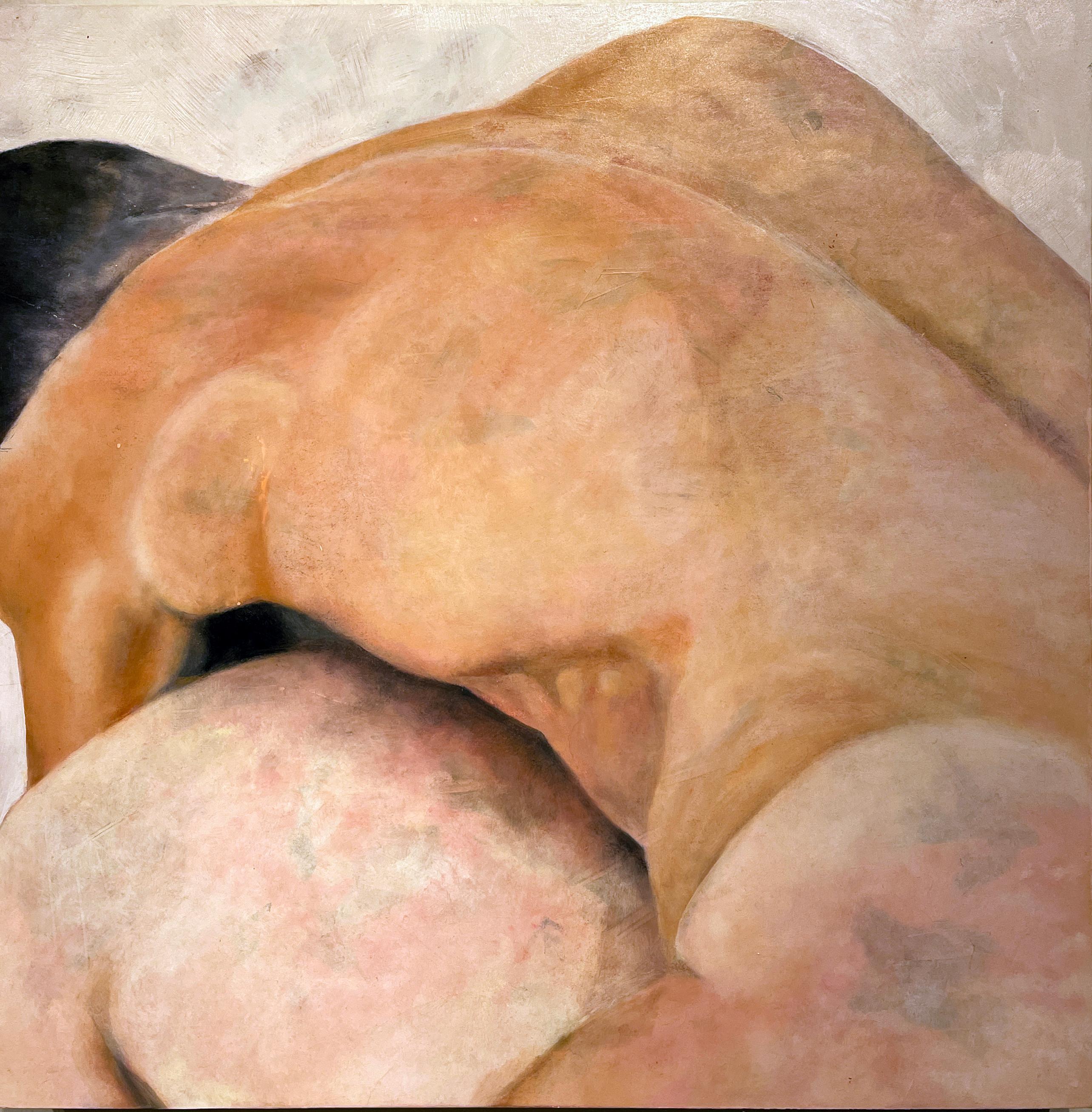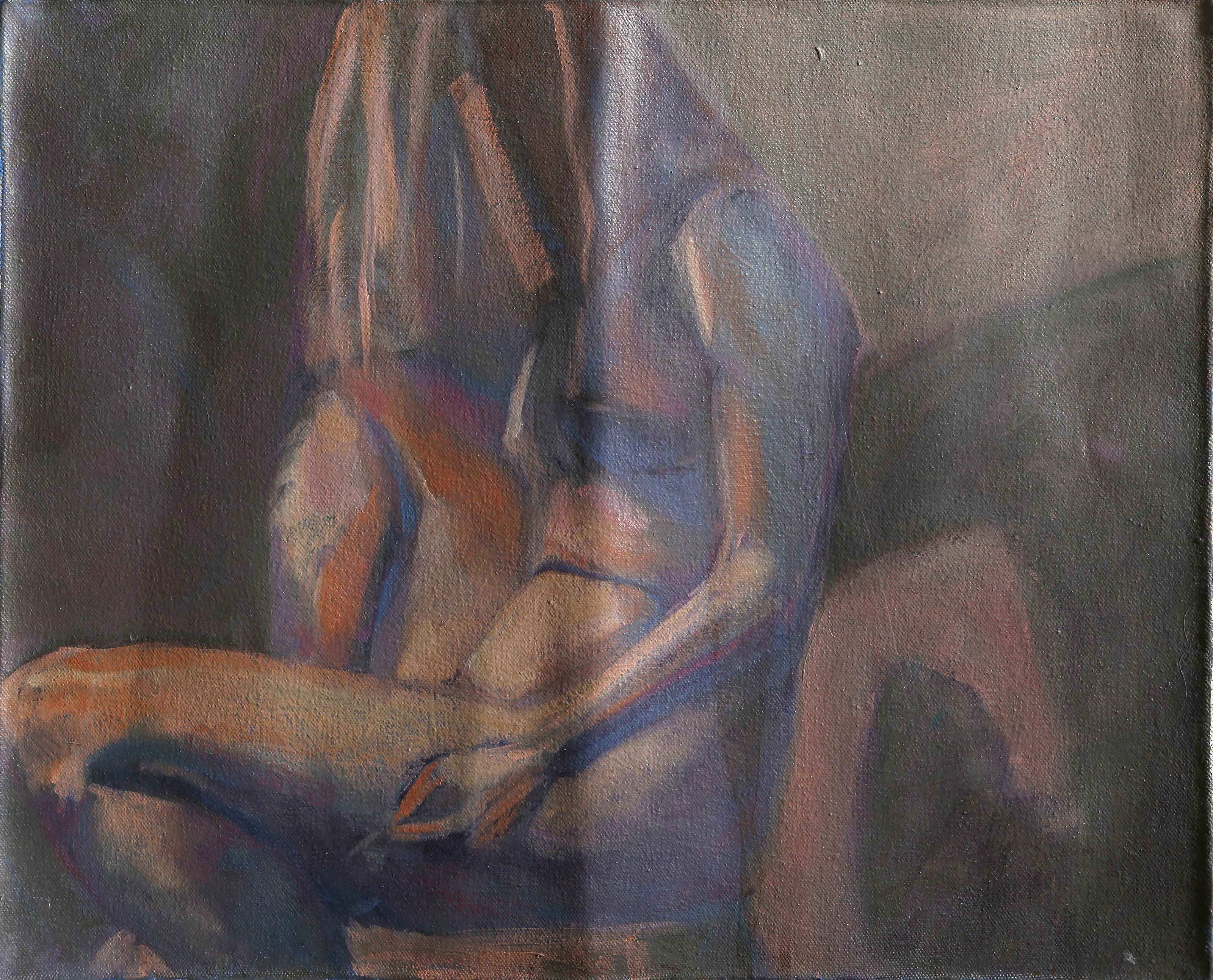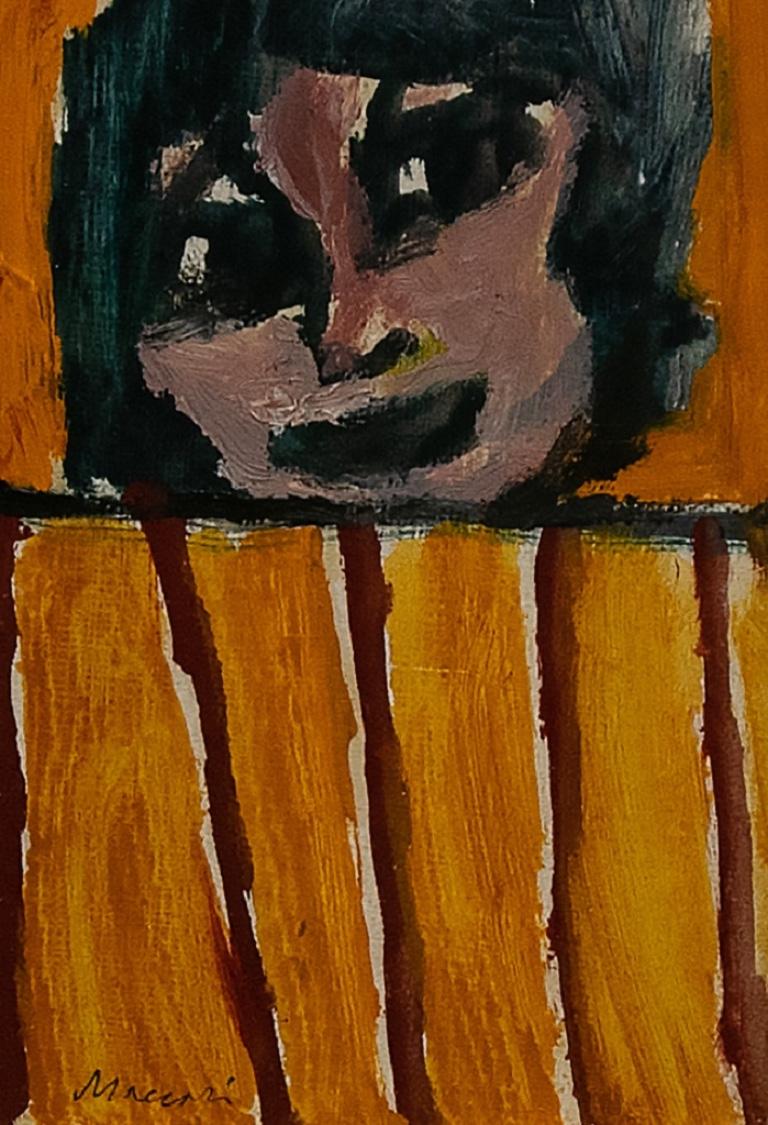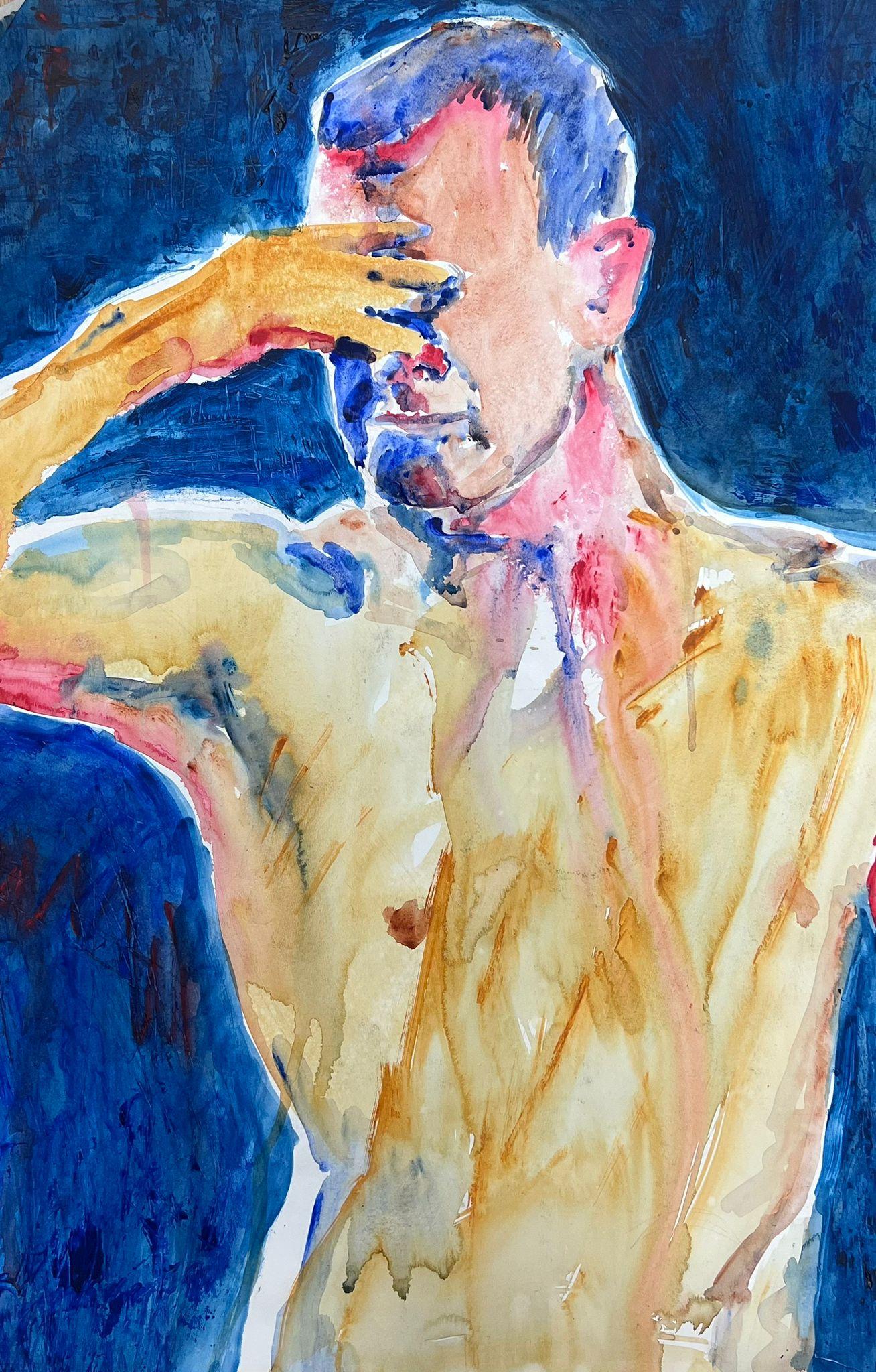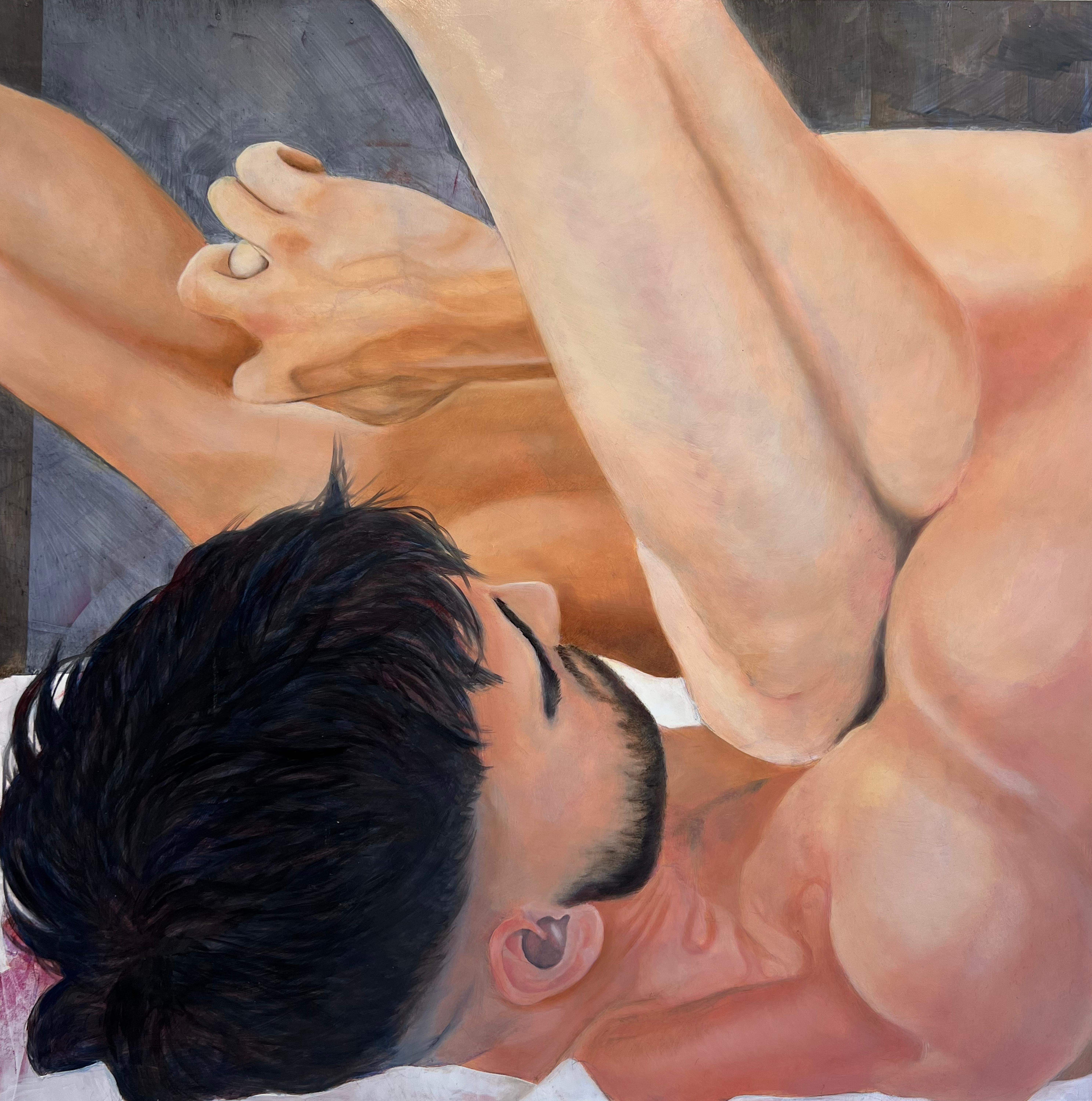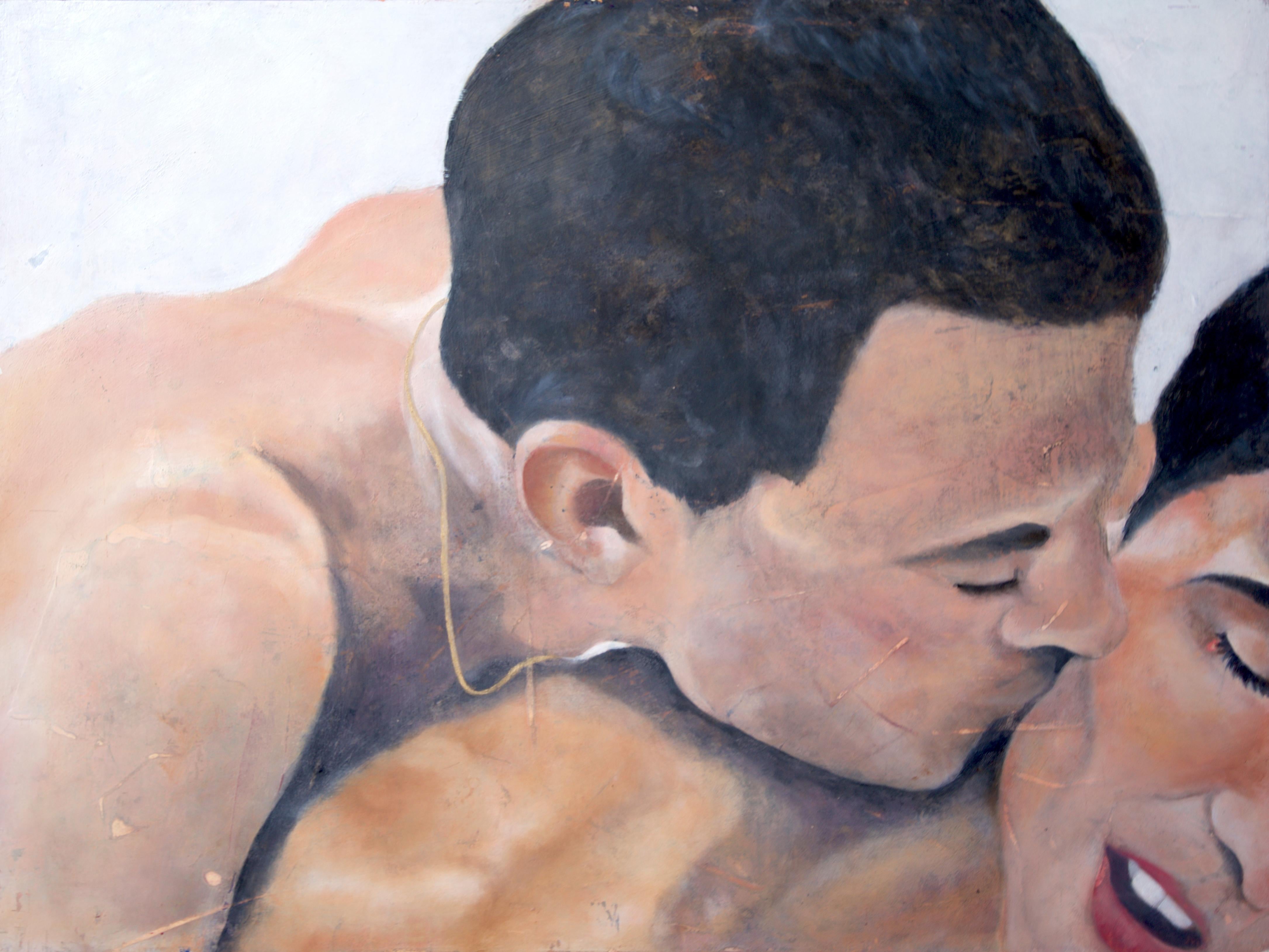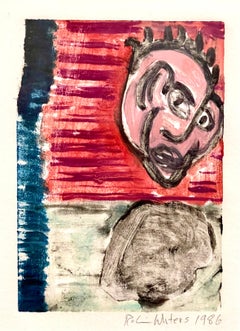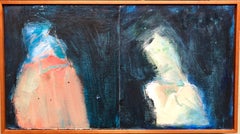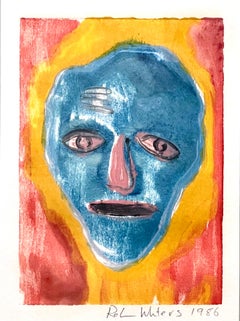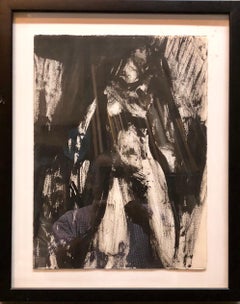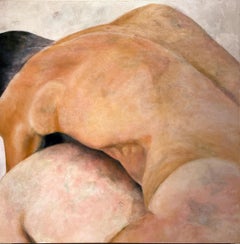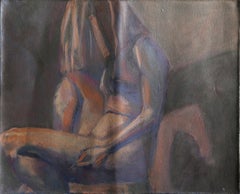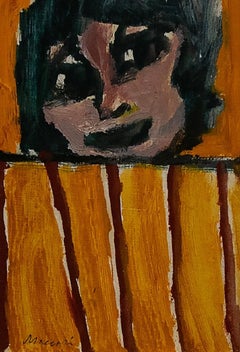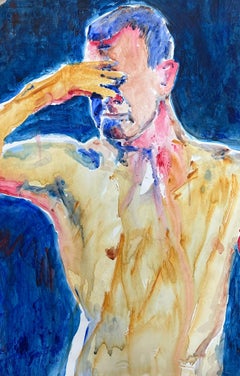Items Similar to Head on Lap, Nude Figures Oil Paintingon Arches Paper
Want more images or videos?
Request additional images or videos from the seller
1 of 10
Martin FullerHead on Lap, Nude Figures Oil Paintingon Arches Paper
$950
£737.38
€840.12
CA$1,357.65
A$1,478.59
CHF 779.61
MX$17,983.88
NOK 9,803.53
SEK 9,194.91
DKK 6,273.45
About the Item
Martin Fuller was born in 1943 in Royal Leamington Spa and his initial studies were at the local Mid–Warwickshire College of Art, from 1960–62. ‘Mid–Warwickshire College was very good’, he says; ‘they taught drawing, and I was a natural image maker, but I wasn’t necessarily a natural drawer. They made me draw objectively. In a way it’s quite beautiful to have gone through that rigour and not to have one’s creativity made dead’.
He moved to London in 1962 to attend Hornsey College of Art, where he became ‘more sybaritically cultured’, then was awarded the Guggenheim–McKinley Scholarship to Italy in 1964. He was in Positano for just under a year and says that it changed his life: in those days there was a thriving artists and writers community, long before the tourist invasion: ‘Although it was the beginning of the supposed swinging sixties, London was still fairly dour, so then I went to Italy with its food culture and more emotional openness…I remember watching a traffic policeman in white jodhpurs and a white hat pinching a girl’s bottom. It was a wonderful revelation of a different way of life’. The Italian light, which was ‘very different from Camden Town’, also influenced his art.
When he returned from Italy he took a job at Hornsey, painted portraits, and then in 1968 had his first one–man show at the Arnolfini gallery in Bristol, which he reckons at that time was probably the best provincial art gallery in Britain. He continued to exhibit widely throughout the 1970s and ’80s.
3cIn 1991 he spent a year as Artist in Residence at Santa Fe in New Mexico. Five years later he won the Discerning Eye Modern Painters Prize and also won first prize in the Hunting Art Prize in 1997. In 2001, Martin was the subject of a retrospective exhibition at Leamington Art Gallery & Museum, and was alarmed when not a single person from his early days in Leamington came to the exhibition, bringing to mind John Betjeman’s poem ‘Death in Leamington Spa’. His most recent exhibition was in December 2005 at Adam Gallery in Mayfair, just up the road from the Royal Academy of Arts, where nowadays he occasionally teaches.
Martin’s work may be found in many collections, including Trinity College, Oxford (1971), Bristol City Art Gallery and Museum (1971 and 1973), and the Sullivan Collection, New York (1995)
He also does watercolours, believing that ‘you can get saturated working in just one medium’. How long does it take him to complete a painting? ‘As one progresses through one’s career, there’s a lot more thought and a lot less work…It might take a poet an hour to physically write down a poem but the composition and thinking behind it might take six months…I tend to do some things and then hide them’. His paintings cost anywhere from £5,000 to £15,000, and he has regular commissions from collectors and other people.
- Creator:Martin Fuller (1943, British)
- Dimensions:Height: 29.5 in (74.93 cm)Width: 34 in (86.36 cm)
- Medium:
- Movement & Style:
- Period:
- Condition:
- Gallery Location:Surfside, FL
- Reference Number:1stDibs: LU38212394132
About the Seller
4.9
Platinum Seller
Premium sellers with a 4.7+ rating and 24-hour response times
Established in 1995
1stDibs seller since 2014
1,824 sales on 1stDibs
Typical response time: 1 hour
- ShippingRetrieving quote...Shipping from: Surfside, FL
- Return Policy
Authenticity Guarantee
In the unlikely event there’s an issue with an item’s authenticity, contact us within 1 year for a full refund. DetailsMoney-Back Guarantee
If your item is not as described, is damaged in transit, or does not arrive, contact us within 7 days for a full refund. Details24-Hour Cancellation
You have a 24-hour grace period in which to reconsider your purchase, with no questions asked.Vetted Professional Sellers
Our world-class sellers must adhere to strict standards for service and quality, maintaining the integrity of our listings.Price-Match Guarantee
If you find that a seller listed the same item for a lower price elsewhere, we’ll match it.Trusted Global Delivery
Our best-in-class carrier network provides specialized shipping options worldwide, including custom delivery.More From This Seller
View AllConceptual Pop Art Color Oil Monotype Painting Abstract Figure Robin Winters
By Robin Winters
Located in Surfside, FL
Robin Winters (American, born 1950),
Untitled (Red Face) from "Cherry Block Series" 1986, monotype, pencil signed and dated lower right, plate: 6"h x 8.5"w, overall (with frame): 22.25"h x 18.25"w. Provenance: Property from a Private Collection, San Francisco.
Winters was invited to make monotypes at Experimental Workshop in San Francisco, (they printed Richard Bosman, Sam Francis, Claire Falkenstein, Deborah Oropallo and Kenneth Noland and many more greats). Winters chose to paint on wood blocks rather than the more usual metal plates in order to capture the organic quality of the natural material. He exploited a salient characteristic of the monoprint in Ghost Story by adding new painted elements onto the increasingly faint ghost images that result from successive impressions from a single block. In so doing he achieved the effect of transparent layers of color and shadow imagery. Winters's brightly-colored monotypes portray an array of figures and landscapes (and an occasional still-life) that, although can be seen in the context of a general trend away from abstraction that has marked the 1980s, defy strict stylistic categorization. They are neither realistic nor abstract, psychological self-examinations nor narrative fictions, but they contain elements of all of these approaches. Like Jonathan Borofsky, Winters derives much of his subject matter from dreams, believing that through his private fears and obsessions he can touch similar emotions in others. Although at first glance Winters's images look as if they could have been made by a child, closer attention reveals sly art historical references to Jackson Pollock and Pattern Painting (the drip and splatter backgrounds), Mark Rothko (the three-part horizontal compositions) and Minimalism (the gridded Cherry Block Series: Bread Beat).
Robin Winters (born 1950 in Benicia, California) is an American conceptual, multi-disciplinary, artist and teacher based in New York. Winters is known for creating solo exhibitions containing an interactive durational performance component to his installations, sometimes lasting up to two months. Winters first emerged in the burgeoning Soho NYC art scene of the 1970s. An early practitioner of the Relational Aesthetics (social interaction as an art medium) Winters also created in works through sculpture, installation, performance, painting, drawing and prints. His art maintains a whimsical spirit, and he often returns to ongoing themes involving faces, boats, cars, bottles, hats and jesters or fools. Winters has incorporated such devices as blind dates, double dates, dinners, fortune telling, and free consultation in his performances. Throughout his career he has engaged in a wide variety of media, such as performance art, film, video, writing prose and poetry, photography, installation art, printmaking, drawing, painting, ceramic sculpture, bronze sculpture, and glassblowing.
Winters was born in Benicia, California in 1950 to lawyer parents. As a child his hobby was collecting glass bottles found on the beach and under old buildings, which would later influence him as an artist. In 1968, Winters had his first durational performance, entitled Norman Thomas Travelling Museum. The artist drove a Volkswagen bus decorated in collage, many of the images relating to current events and politics. Inside was what the artist described as a “reliquary” containing many objects, including a bottle collection. Winters took the van to shopping centers and even as far as Mexico. That same year, Winters opted not to register for the military draft. Although he was deemed fit to serve, Winters refused. In 1975 the resulting legal proceedings finally came to a close after it was proven that the artist had been harassed by the local draft board. In his teens and early twenties, Winters became acquainted with several local artists who helped shape his aesthetic, most notably Manuel Neri and Robert Arneson. By the early 1970s, Winters was studying at the San Francisco Art Institute (SFAI) and had relocated to San Francisco. At this time Winters became friends with the Bay Area conceptual artists Terry Fox and Howard Fried, and participated in several of Fried's performance works. In 1972 Winters was accepted into the Whitney Independent Study Program in New York City. After coming to New York City, Winters helped support himself by working for various artists, among them the performance artist Joan...
Category
1980s Pop Art Figurative Paintings
Materials
Monoprint, Monotype
"Two for Francis" Mixed Media Figural Abstract Oil Painting
By Marianne Kolb
Located in Surfside, FL
Marianne Kolb (born 1958 in Bern) is a self-taught Swiss painter currently living in the United States. She is known for her emotionally-charged figurative paintings that address the human condition. Kolb paints directly onto canvas with her hands, placing her figures in isolation on a monochromatic...
Category
Early 2000s Abstract Impressionist Abstract Paintings
Materials
Paper, Varnish, Oil, Board
Conceptual Pop Art Color Oil Monotype Painting Abstract Figure Robin Winters
By Robin Winters
Located in Surfside, FL
Robin Winters (American, born 1950),
Untitled (Red Face) from "Cherry Block Series" 1986, monotype, pencil signed and dated lower right, plate: 6"h x 8.5"w, overall (with frame): 22.25"h x 18.25"w. Provenance: Property from a Private Collection, San Francisco.
Winters was invited to make monotypes at Experimental Workshop in San Francisco, (they printed Richard Bosman, Sam Francis, Claire Falkenstein, Deborah Oropallo and Kenneth Noland and many more greats). Winters chose to paint on wood blocks rather than the more usual metal plates in order to capture the organic quality of the natural material. He exploited a salient characteristic of the monoprint in Ghost Story by adding new painted elements onto the increasingly faint ghost images that result from successive impressions from a single block. In so doing he achieved the effect of transparent layers of color and shadow imagery. Winters's brightly-colored monotypes portray an array of figures and landscapes (and an occasional still-life) that, although can be seen in the context of a general trend away from abstraction that has marked the 1980s, defy strict stylistic categorization. They are neither realistic nor abstract, psychological self-examinations nor narrative fictions, but they contain elements of all of these approaches. Like Jonathan Borofsky, Winters derives much of his subject matter from dreams, believing that through his private fears and obsessions he can touch similar emotions in others. Although at first glance Winters's images look as if they could have been made by a child, closer attention reveals sly art historical references to Jackson Pollock and Pattern Painting (the drip and splatter backgrounds), Mark Rothko (the three-part horizontal compositions) and Minimalism (the gridded Cherry Block Series: Bread Beat).
Robin Winters (born 1950 in Benicia, California) is an American conceptual, multi-disciplinary, artist and teacher based in New York. Winters is known for creating solo exhibitions containing an interactive durational performance component to his installations, sometimes lasting up to two months. Winters first emerged in the burgeoning Soho NYC art scene of the 1970s. An early practitioner of the Relational Aesthetics (social interaction as an art medium) Winters also created in works through sculpture, installation, performance, painting, drawing and prints. His art maintains a whimsical spirit, and he often returns to ongoing themes involving faces, boats, cars, bottles, hats and jesters or fools. Winters has incorporated such devices as blind dates, double dates, dinners, fortune telling, and free consultation in his performances. Throughout his career he has engaged in a wide variety of media, such as performance art, film, video, writing prose and poetry, photography, installation art, printmaking, drawing, painting, ceramic sculpture, bronze sculpture, and glassblowing.
Winters was born in Benicia, California in 1950 to lawyer parents. As a child his hobby was collecting glass bottles found on the beach and under old buildings, which would later influence him as an artist. In 1968, Winters had his first durational performance, entitled Norman Thomas Travelling Museum. The artist drove a Volkswagen bus decorated in collage, many of the images relating to current events and politics. Inside was what the artist described as a “reliquary” containing many objects, including a bottle collection. Winters took the van to shopping centers and even as far as Mexico. That same year, Winters opted not to register for the military draft. Although he was deemed fit to serve, Winters refused. In 1975 the resulting legal proceedings finally came to a close after it was proven that the artist had been harassed by the local draft board. In his teens and early twenties, Winters became acquainted with several local artists who helped shape his aesthetic, most notably Manuel Neri and Robert Arneson. By the early 1970s, Winters was studying at the San Francisco Art Institute (SFAI) and had relocated to San Francisco. At this time Winters became friends with the Bay Area conceptual artists Terry Fox and Howard Fried, and participated in several of Fried's performance works. In 1972 Winters was accepted into the Whitney Independent Study Program in New York City. After coming to New York City, Winters helped support himself by working for various artists, among them the performance artist Joan...
Category
1980s Pop Art Figurative Paintings
Materials
Monoprint, Monotype
Abstract Figure Study of a Nude Woman Oil Painting
By Jamie Marin-Price
Located in Surfside, FL
Jamie, is an American artist born in Washington, D.C. in 1970. He was educated in the Metropolitan Washington D.C. area and received his art instruction from the prestigious Corcoran...
Category
Late 20th Century Modern Nude Drawings and Watercolors
Materials
Paper, Oil
Mixed Media Painting Minnesota Woman Artist Figurative Abstract
By Nancy Randall
Located in Surfside, FL
Known for her painting and sculpture as well as printmaking. Nancy Randall’s work is featured in collections at the Smithsonian Institution, the Walker Art Center, the Nelson Atkins ...
Category
1980s Abstract Expressionist Still-life Paintings
Materials
Paint, Oil Pastel, Mixed Media
Untitled Couple Mid Century Jewish Expressionist OIl Painting
By Belle Golinko
Located in Surfside, FL
Abstracted painting of a man and a woman, the paint has been applied to textured plastic.
An abstracted painting of a couple applying paint to the textured plastic surface. Genre Expressionist Fauvist Subject People Medium Acrylic Plastic Surface Board Country United States Dimensions 24" x 11 1/2"
She exhibited her painting at the famous Jewish art show held at the Dallas Museum
Contemporary Fine Arts Exhibition of the American Jewish Tercentenary in 1955 alogside artists Aarons, George, Benn, Ben, Berkman, Aaron, Bloom, Hyman
Bohrod, Aaron Gottlieb, Adolph, Gropper, William, Gross, Chaim Gurr, Lena amongst others.
Born in 1899, Belle Golinko is a listed Jewish mid...
Category
1950s Expressionist Figurative Paintings
Materials
Plastic, Oil
You May Also Like
Shield Me - Nude Figures, Intimate Portrayal of a Couple, Original Oil on Panel
By Rick Sindt
Located in Chicago, IL
Using pornography as a vehicle for understanding, Rick Sindt's work explores the discovery and development of queer attraction. Sindt transforms pornographi...
Category
2010s Contemporary Figurative Paintings
Materials
Oil, Panel
Profile of Nude Woman III, Modern Oil Painting by Lisa Martin
Located in Long Island City, NY
Lisa Martin - Profile of Nude Woman III, Year: circa 2000, Medium: Oil on Canvas, Size: 14.75 x 18 in. (37.47 x 45.72 cm)
Category
Early 2000s Modern Nude Paintings
Materials
Oil
Figure - Painting by Mino Maccari - 1960ca
By Mino Maccari
Located in Roma, IT
Figure is an original painting realized in 1960 ca by Mino Maccari (1898-1989).
Hand-signed in pencil lower left.
In good conditions.
The subject of this artwork is female figu...
Category
1960s Modern Figurative Drawings and Watercolors
Materials
Canvas, Oil
Nude Man Half Length Portrait Modern British Contemporary Painting Very Large
Located in Cirencester, Gloucestershire
The Male Nude (half length)
by Helen Greenfield (British 20th century)
oil painting on artist paper, unframed
board: 33 x 23 inches
condition: overall very good - some creasing to t...
Category
20th Century Modern Figurative Paintings
Materials
Watercolor
No One Is Sure - Nude Figures, Intimate Portrayal of a Couple, Original Oil
By Rick Sindt
Located in Chicago, IL
Using pornography as a vehicle for understanding, Rick Sindt's work explores the discovery and development of queer attraction. Sindt transforms pornographi...
Category
2010s Contemporary Figurative Paintings
Materials
Oil, Panel
Did I Steal You Away? - Intimate Painting of a Couple Embracing, Original Oil
By Rick Sindt
Located in Chicago, IL
Using pornography as a vehicle for understanding, Rick Sindt's work explores the discovery and development of queer attraction. Sindt transforms pornographic stills, repurposing them into images of intimacy.
Rick Sindt
Did I Steal You Away?
oil on panel
18h x 24w x 1.50d in
45.72h x 60.96w x 3.81d cm
RIS036
“This body of work has been crystalizing in my mind for about five years,” says Sindt, “It is the product of reflecting on how the places I learned the most about myself, and my desires, are considered something that sullies a person, something taboo.”
Focused on the experiences of gay men, this body of oil paintings depicts moments that range from tender touches to more sexually explicit...
Category
2010s Contemporary Figurative Paintings
Materials
Oil, Panel
More Ways To Browse
Fuller Vintage
Oil Painting Arches
Vintage Policeman
Pino Art Oil Painting
Pino Oil Painting
Antique Monte Carlo
Judaica Artist
Oil Painting Sisters
Social Realism Painting
Tango Dancers
African Painter
Band Posters
Leon Bonnat
Mary Magdalene
Max Studio
Mickey Mouse Painting
Oil Painting Morgan
Old Master Painting Flemish
